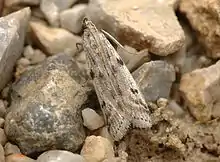Phycitodes binaevella
Phycitodes binaevella is a species of snout moth described by Jacob Hübner in 1813. It is found in most of Europe (except Portugal),[1] Asia Minor, Lebanon and the Palestinian Territories.[2]
| Phycitodes binaevella | |
|---|---|
 | |
| Scientific classification | |
| Kingdom: | Animalia |
| Phylum: | Arthropoda |
| Class: | Insecta |
| Order: | Lepidoptera |
| Family: | Pyralidae |
| Genus: | Phycitodes |
| Species: | P. binaevella |
| Binomial name | |
| Phycitodes binaevella (Hübner, 1813) | |
| Synonyms | |
| |
The wingspan is 18–27 millimetres (0.71–1.06 in).[3] There is one generation with adults on wing from July to August.[4]
The larvae feed on Cirsium vulgare, Carduus, Aster, Tanacetum vulgare and Artemisia vulgaris.[5] They feed inside the flowerheads of their host plant. The species overwinters as a fully grown larva. Pupation takes place in spring in a cocoon on the soil surface.[6]
References
- "Phycitodes binaevella (Hübner, 1813)". Fauna Europaea. Retrieved 22 February 2012.
- "World Pyraloidea Database". Globiz.pyraloidea.org. Retrieved 2012-02-22.
- microlepidoptera.nl
- UKMoths
- Savela, Markku. "Phycitodes Hampson, 1917". Lepidoptera and Some Other Life Forms. Retrieved August 24, 2017.
- Lot moths and butterflies
This article is issued from Wikipedia. The text is licensed under Creative Commons - Attribution - Sharealike. Additional terms may apply for the media files.